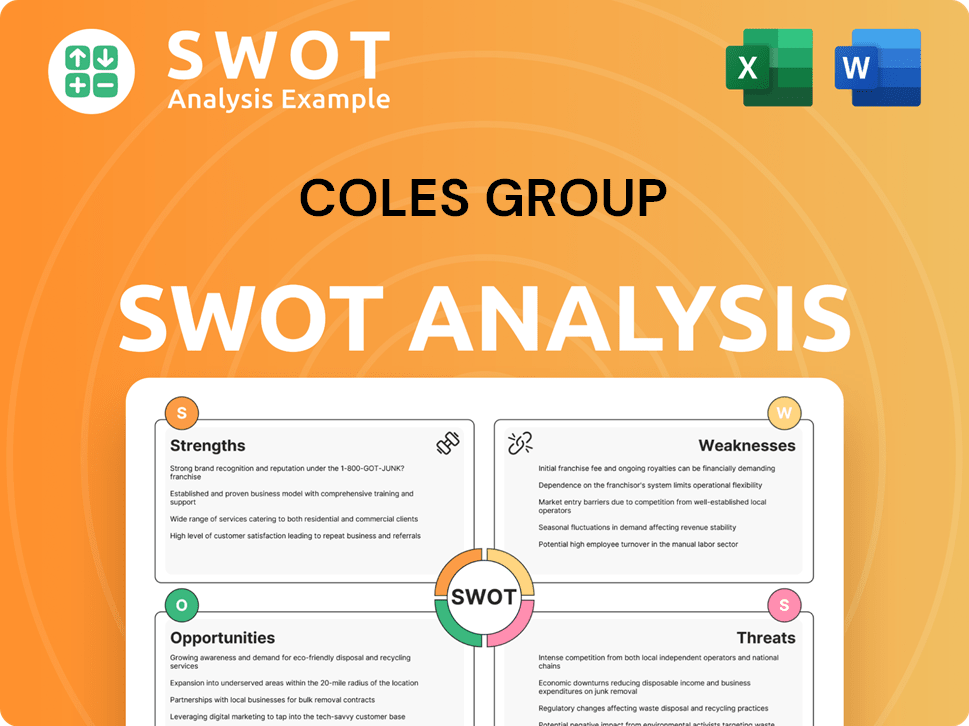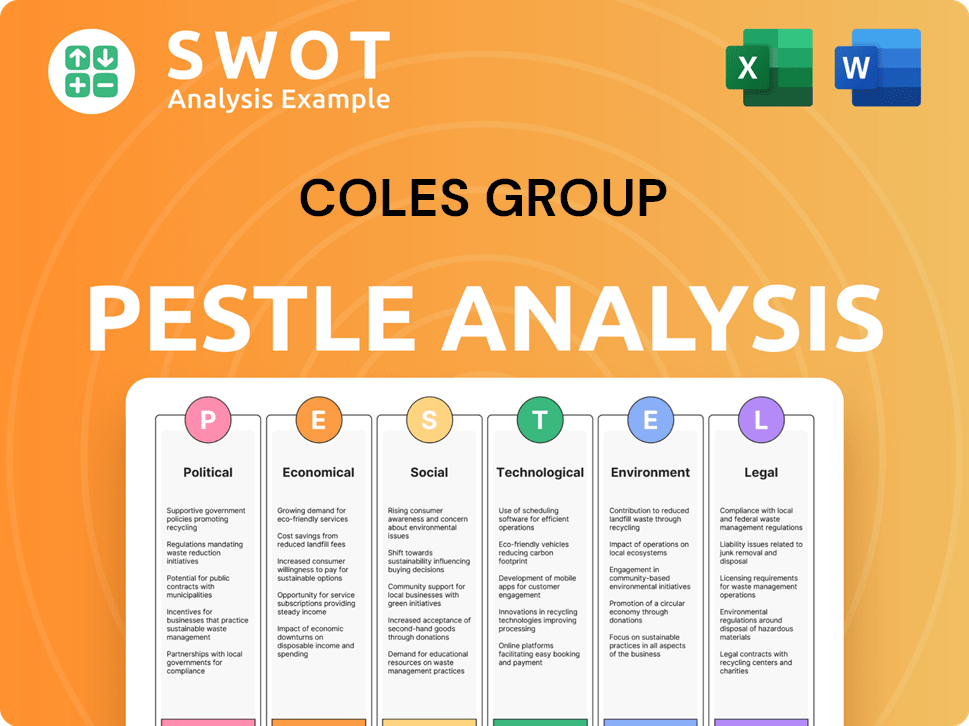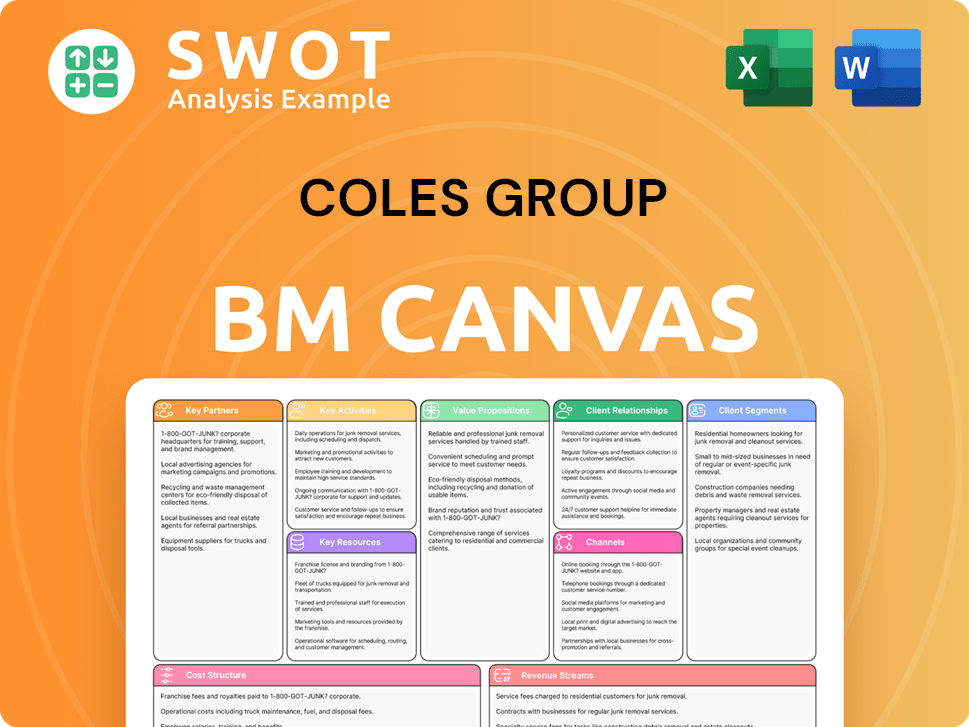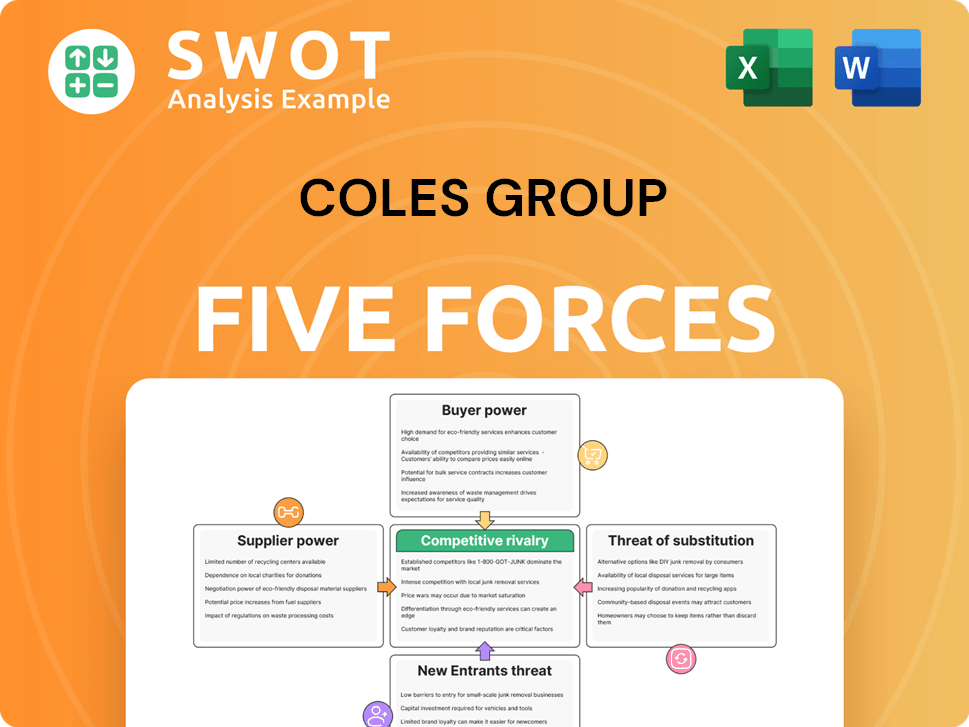Coles Group Bundle
How did Coles Group evolve from a single store to a retail giant?
Journey back in time to explore the fascinating Coles Group SWOT Analysis and its remarkable ascent in the Australian market. From its humble beginnings in 1914 as a 'variety store,' the Coles brand has transformed into a retail powerhouse. Discover the strategic decisions and innovative approaches that have shaped the Coles company into a household name.

This exploration into the Coles history will uncover the key milestones that defined its trajectory. Learn about the early days of Coles Supermarkets and the evolution of Coles stores. Understand the competitive landscape and the strategies that have cemented Coles Group's position as a leading Australian supermarket.
What is the Coles Group Founding Story?
The story of the Coles Group begins on April 9, 1914. That's when George James Coles and his brothers opened their first store, GJ Coles & Co., in Collingwood, Victoria. This marked the start of a retail revolution in Australia.
George Coles, drawing on his experience, saw a chance to change how people shopped. He wanted to offer a wide variety of goods at prices everyone could afford. The original motto of 'nothing over one shilling' set the tone for transparent pricing, a big shift from the haggling of the time.
The early business model was all about selling lots of general merchandise, like stationery and household items. The Coles family put up the initial funds themselves. This focus on fast sales and happy customers helped build a loyal customer base. The growing cities and demand for goods in early 20th-century Australia created the perfect environment for Coles' new idea to thrive.
Coles Group started with a single store in 1914, focusing on variety and affordability.
- The initial store, GJ Coles & Co., offered a wide range of general merchandise.
- The pricing strategy was revolutionary, with a 'nothing over one shilling' policy.
- The company's early success was built on quick turnover and customer satisfaction.
- The economic conditions of early 20th-century Australia supported Coles' growth.
The Owners & Shareholders of Coles Group have seen the company evolve significantly since its inception. The early focus on general merchandise expanded over time.
Coles Group SWOT Analysis
- Complete SWOT Breakdown
- Fully Customizable
- Editable in Excel & Word
- Professional Formatting
- Investor-Ready Format

What Drove the Early Growth of Coles Group?
The early growth of the Coles Group was marked by a swift expansion of its variety store model across Victoria and beyond. Following the success of its initial store, the company strategically opened new stores in high-traffic urban areas. This expansion was fueled by a focus on offering a diverse range of general merchandise and value-driven pricing, which quickly resonated with consumers. Initial growth involved hiring local staff for each new store, emphasizing efficient operations and excellent customer service.
The Coles history includes a rapid expansion phase where new stores were opened strategically in major urban areas. This growth was supported by a customer-centric approach and efficient operational strategies. The focus was on providing value and a wide selection of goods to attract a broad customer base, contributing to the early success of the Coles brand.
A significant strategic move was the company's entry into food retailing during the 1930s. This shift laid the foundation for its future as a major Australian supermarket. This diversification into food was a pivotal decision that reshaped the company's trajectory, setting the stage for its evolution into a comprehensive grocery provider.
The leadership of the Coles family played a crucial role in guiding the company's expansion during this period. Sir George Coles, for example, served as Chairman for many years, influencing the company's strategic direction. Key decisions, such as the move into food retailing, were instrumental in solidifying the company's position in the Australian retail sector.
The market responded positively to Coles' expanding retail model, which offered competitive pricing and a growing product range. The competitive landscape, initially dominated by smaller, independent retailers, saw Coles emerge as a formidable force. For more insights, you can explore the Competitors Landscape of Coles Group.
Coles Group PESTLE Analysis
- Covers All 6 PESTLE Categories
- No Research Needed – Save Hours of Work
- Built by Experts, Trusted by Consultants
- Instant Download, Ready to Use
- 100% Editable, Fully Customizable

What are the key Milestones in Coles Group history?
The Coles Group has a rich history, marked by significant achievements and strategic pivots. From its early days as a small chain of stores to its current status as a leading Australian supermarket, Coles has consistently adapted to changing market dynamics and consumer preferences, solidifying its position in the competitive landscape.
| Year | Milestone |
|---|---|
| 1914 | Coles was founded by George James Coles in Melbourne, starting as a single store. |
| 1950s | Coles pioneered self-service supermarkets in Australia, revolutionizing the grocery shopping experience. |
| 1980s | Coles expanded significantly through acquisitions, consolidating its presence in the Australian market. |
| 2000s | Coles underwent major restructuring and strategic realignments to enhance efficiency and competitiveness. |
| 2018 | Coles was demerged from Wesfarmers and listed as a separate entity on the Australian Securities Exchange. |
| 2020s | Coles invested heavily in online retail and supply chain modernization to meet evolving customer demands. |
Innovations have been central to the
Coles was one of the first to introduce self-service supermarkets in Australia, improving customer experience and operational efficiency. This innovation allowed for faster checkouts and a wider variety of products available to customers.
Coles has focused on optimizing its supply chain to ensure product freshness and availability. This includes strategic partnerships with local farmers and suppliers.
Significant investments in online retail capabilities have been made to meet the growing demand for online grocery shopping. Coles has expanded its online presence to offer more convenience to customers.
Challenges have shaped the trajectory of the
Economic recessions have impacted consumer spending, requiring Coles to adapt pricing and product offerings. The company has had to adjust its strategies to maintain profitability during challenging economic times.
The Australian supermarket sector is highly competitive, primarily with Woolworths, necessitating continuous innovation and efficiency improvements. Coles has faced constant pressure to differentiate itself in the market.
Internal crises, such as supply chain disruptions, have tested the company's resilience. These disruptions have required quick responses to maintain product availability.
Coles Group Business Model Canvas
- Complete 9-Block Business Model Canvas
- Effortlessly Communicate Your Business Strategy
- Investor-Ready BMC Format
- 100% Editable and Customizable
- Clear and Structured Layout

What is the Timeline of Key Events for Coles Group?
The journey of Coles Group, a prominent Australian supermarket, is marked by significant milestones that have shaped its evolution. From its humble beginnings as a variety store to its current status as a leading retailer, Coles history reflects a strategic adaptation to the changing retail landscape. Key events such as the introduction of self-service supermarkets, the formation of Coles Myer Limited, and the subsequent demerger from Wesfarmers have been pivotal in its growth. The company's commitment to innovation, including substantial investment in online retail and supply chain modernization, positions it for continued success in the competitive market.
| Year | Key Event |
|---|---|
| 1914 | George James Coles opened the first GJ Coles & Co. variety store in Collingwood, Victoria, marking the beginning of the Coles brand. |
| 1930s | Coles began its expansion into food retailing, laying the foundation for its future supermarket operations and establishing its presence in the Australian supermarket sector. |
| 1950s | Coles pioneered self-service supermarkets in Australia, revolutionizing the grocery shopping experience for consumers. |
| 1960 | Coles listed on the Australian Stock Exchange, signifying a major step in its corporate growth. |
| 1973 | Coles acquired the Bi-Lo supermarket chain, broadening its retail footprint and market reach. |
| 1986 | Coles Myer Limited was formed through the merger of Coles and Myer, creating a retail conglomerate. |
| 2007 | Wesfarmers acquired Coles Group in Australia's largest corporate takeover at the time. |
| 2018 | Coles Group demerged from Wesfarmers and relisted as an independent company on the ASX, marking a new chapter in its corporate structure. |
| 2020-2022 | Significant investment and acceleration in online retail capabilities and supply chain modernization, reflecting a commitment to digital transformation. |
| 2024 | Coles reported strong digital growth, with online sales up 6.8% in the first half of FY24, highlighting its success in the e-commerce space. |
Coles is focused on enhancing its omni-channel retail experience, seamlessly integrating physical stores with online platforms. This includes continued investment in e-commerce infrastructure and last-mile delivery solutions to meet evolving customer preferences. The goal is to provide a cohesive shopping experience across all channels, driving customer loyalty and sales growth.
The company aims to further optimize its supply chain efficiency through technological advancements and automation. This includes initiatives to reduce costs, improve product availability, and enhance overall operational performance. These efforts are designed to ensure a resilient and responsive supply chain.
Coles is committed to its sustainability agenda, with targets related to reducing carbon emissions, minimizing food waste, and sustainable sourcing. The company aims to be powered by 100% renewable electricity by the end of FY25, reflecting its dedication to environmental responsibility. This commitment is a core part of their business strategy.
Analyst predictions indicate a continued focus on digital transformation and supply chain resilience for major retailers like Coles. This includes leveraging data analytics, enhancing online platforms, and investing in innovative technologies to improve customer experience and operational efficiency. Leadership emphasizes delivering value to customers and shareholders through innovation.
Coles Group Porter's Five Forces Analysis
- Covers All 5 Competitive Forces in Detail
- Structured for Consultants, Students, and Founders
- 100% Editable in Microsoft Word & Excel
- Instant Digital Download – Use Immediately
- Compatible with Mac & PC – Fully Unlocked

Related Blogs
- What is Competitive Landscape of Coles Group Company?
- What is Growth Strategy and Future Prospects of Coles Group Company?
- How Does Coles Group Company Work?
- What is Sales and Marketing Strategy of Coles Group Company?
- What is Brief History of Coles Group Company?
- Who Owns Coles Group Company?
- What is Customer Demographics and Target Market of Coles Group Company?
Disclaimer
All information, articles, and product details provided on this website are for general informational and educational purposes only. We do not claim any ownership over, nor do we intend to infringe upon, any trademarks, copyrights, logos, brand names, or other intellectual property mentioned or depicted on this site. Such intellectual property remains the property of its respective owners, and any references here are made solely for identification or informational purposes, without implying any affiliation, endorsement, or partnership.
We make no representations or warranties, express or implied, regarding the accuracy, completeness, or suitability of any content or products presented. Nothing on this website should be construed as legal, tax, investment, financial, medical, or other professional advice. In addition, no part of this site—including articles or product references—constitutes a solicitation, recommendation, endorsement, advertisement, or offer to buy or sell any securities, franchises, or other financial instruments, particularly in jurisdictions where such activity would be unlawful.
All content is of a general nature and may not address the specific circumstances of any individual or entity. It is not a substitute for professional advice or services. Any actions you take based on the information provided here are strictly at your own risk. You accept full responsibility for any decisions or outcomes arising from your use of this website and agree to release us from any liability in connection with your use of, or reliance upon, the content or products found herein.